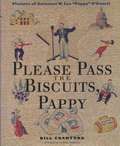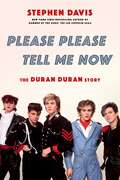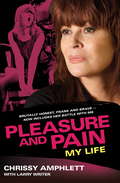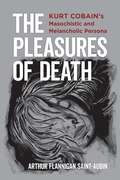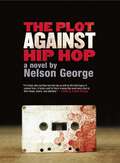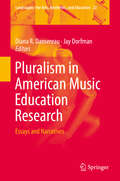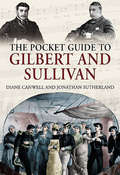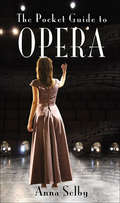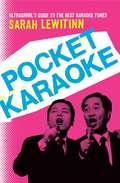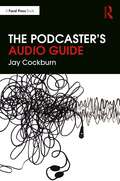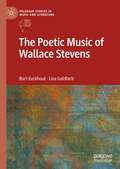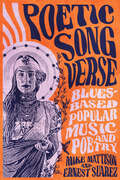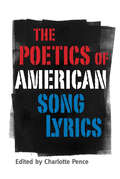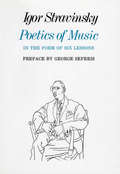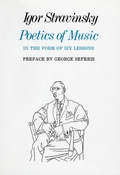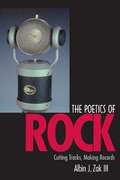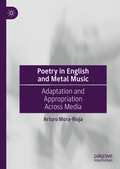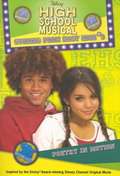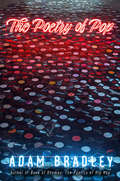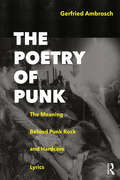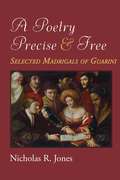- Table View
- List View
Please Pass the Biscuits, Pappy: Pictures of Governor W. Lee "Pappy" O'Daniel
by Bill Crawford John AndersonLong before movie stars Ronald Reagan and Arnold Schwarzenegger became governors of California, a popular radio personality with no previous political experience—who wasn't even registered to vote—swept into the governor's office of Texas. W. Lee "Pappy" O'Daniel was a 1930s businessman who discovered the power of radio to sell flour.<P><P> His musical shows with the Light Crust Doughboys (which launched the career of Bob Wills) and his radio homilies extolling family and Christian values found a vast, enthusiastic audience in Depression-era Texas. When Pappy decided to run for governor in 1938 as a way to sell more flour—a fact he proudly proclaimed throughout the campaign—the people of Texas voted for him in record numbers. And despite the ineptitude for politics he displayed once in office, Texans returned him to the governorship in 1940 and then elected him to the U.S. Senate in 1941 in a special election in which he defeated Lyndon Johnson, as well as to a full term as senator in 1942.
Please Please Tell Me Now: The Duran Duran Story
by Stephen DavisLifelong fans and interested newcomers will love this stunning biography of Duran Duran by the bestselling author of Gold Dust Woman and Hammer of the Gods.In Please Please Tell Me Now, bestselling rock biographer Stephen Davis tells the story of Duran Duran, the quintessential band of the 1980s. Their pretty boy looks made them the stars of fledgling MTV, but it was their brilliant musicianship that led to a string of number one hits. By the end of the decade, they had sold 60 million albums; today, they've sold over 100 million albums—and counting.Davis traces their roots to the austere 1970s British malaise that spawned both the Sex Pistols and Duran Duran—two seemingly opposite music extremes. Handsome, British, and young, it was Duran Duran that headlined Live Aid, not Bob Dylan or Led Zeppelin. The band moved in the most glamorous circles: Nick Rhodes became close with Andy Warhol, Simon LeBon with Princess Diana, and John Taylor dated quintessential British bad girl Amanda De Cadanet. With timeless hits like "Hungry Like the Wolf," "Girls on Film," "Rio," "Save a Prayer," and the bestselling James Bond theme in the series' history, "A View to Kill," Duran Duran has cemented its legacy in the pop pantheon—and with a new album and a worldwide tour on the way, they show no signs of slowing down anytime soon. Featuring exclusive interviews with the band and never-before-published photos from personal archives, Please Please Tell Me Now offers a definitive account of one of the last untold sagas in rock and roll history—a treat for diehard fans, new admirers, and music lovers of any age.
Pleasure and Pain: My Life
by Chrissy Amphlett Larry WriterChrissy Amphlett is a true legend of Australian rock?n?roll. Here, the spellbinding performer who inspired and outraged as lead singer of the Divinyls tells her own amazing story.In this raw, gripping and searingly honest account, Chrissy spares no one ? least of all herself. She reveals how she formed the Divinyls and, with a unique voice, steely ambition and an outrageous stage act powered them to Australian and international stardom.Having battled alcohol, drugs and a million dollars worth of debt, Chrissy tells of her fight with MS and of finally finding peace with the love of her life in New York.Brave, sad, funny, ferocious, there's never been anyone like Chrissy Amphlett.
The Pleasures of Death: Kurt Cobain’s Masochistic and Melancholic Persona
by Arthur Flannigan Saint-AubinThe year 2019 marked the twenty-fifth anniversary of the death of Kurt Cobain, an artist whose music, words, and images continue to move millions of fans worldwide. As the first academic study that provides a literary analysis of Cobain’s creative writings, Arthur Flannigan Saint-Aubin’s The Pleasures of Death: Kurt Cobain’s Masochistic and Melancholic Persona approaches the journals and songs crafted by Nirvana’s iconic front man from the perspective of cultural theory and psychoanalytic aesthetics.Drawing on critiques and reformulations of psychoanalytic theory by feminist, queer, and antiracist scholars, Saint-Aubin considers the literary means by which Cobain creates the persona of a young, white, heterosexual man who expresses masochistic and melancholic behaviors. On the one hand, this individual welcomes pain and humiliation as atonement for unpardonable sins; on the other, he experiences a profound sense of loss and grief, seeking death as the ultimate act of pleasure. The first-person narrators and characters that populate Cobain’s texts underscore the political and aesthetic repercussions of his art. Cobain’s distinctive version of grunge, understood as a subculture, a literary genre, and a cultural practice, represents a specific performance of race and gender, one that facilitates an understanding of the self as part of a larger social order. Saint-Aubin approaches Cobain’s writings independently of the artist’s biography, positioning these texts within the tradition of postmodern representations of masculinity in twentieth-century American fiction, while also suggesting connections to European Romantic traditions from the nineteenth century that postulate a relation between melancholy (or depression) and creativity. In turn, through Saint-Aubin’s elegant analysis, Cobain’s creative writings illuminate contradictions and inconsistencies within psychoanalytic theory itself concerning the intersection of masculinity, masochism, melancholy, and the death drive.By foregrounding Cobain’s ability to challenge coextensive links between gender, sexuality, and race, The Pleasures of Death reveals how the cultural politics and aesthetics of this tragic icon’s works align with feminist strategies, invite queer readings, and perform antiracist critiques of American culture.
The Plot Against Hip Hop: A Novel (A D Hunter Mystery #2)
by Nelson GeorgeFinalist for the 2012 NAACP Image Award in Literature!"George is an ace at interlacing the real dramas of the world...the book's slim length and flyweight depth could make it an artifact of this particular zeitgeist in American history. Playas and haters and celebrity cameos fuel a novel that is wickedly entertaining while being frozen in time."--Kirkus Reviews"This hard-boiled tale is jazzed up with authentic street slang and name-dropping (Biggie, Mary J. Blige, Lil Wayne, and Chuck D)...George's tightly packaged mystery pivots on a believable conspiracy...and his street cred shines in his descriptions of Harlem and Brownsville's mean streets."--Library Journal"George is a well-known, respected hip-hop chronicler...Now he adds crime fiction to his resume with a carefully plotted crime novel peopled by believable characters and real-life hip-hop personalities."--Booklist"George's prose sparkles with an effortless humanity, bringing his characters to life in a way that seems true and beautiful. The story--and the conspiracy behind it--is one we all need to hear as consumers and creators in the post-hardcore hip-hop world."--Shelf Awareness"Part procedural murder mystery, part conspiracy-theory manifesto, Nelson George's The Plot Against Hip Hop reads like the PTSD fever dream of a renegade who's done several tours of duty in the trenches...Plot's combination of record-biz knowledge and ghetto fabulosity could have been written only by venerable music journalist Nelson George, who knows his hip-hop history...The writing is as New York as 'Empire State of Mind,' and D is a detective compelling enough to anchor a series."--Time Out New York"A breakbeat detective story...George invents as much as he curates, as outlandish conspiracy theories clash with real-life figures. But what makes the book such a fascinating read is its simultaneous strict adherence to hip-hop's archetypes and tropes while candidly acknowledging the absurdity of the music's current big-business era. There's a late-capitalism logic at work here. If this book had been written in the early '90s, it would have been about the insurgent artistry of hip-hop musicians and the social-justice strides the genre was effecting. Today, it's a procedural about the death of principles."--Time Out Chicago"Like good hip hop, there is social commentary and a blurring of the lines between great storytelling and all-to-real happenings. The Plot Against Hip Hop reads almost like Thomas Pynchon's Inherent Vice, but in the world of rap music. Brilliant prose, vast conspiracy, (at times) borderline trippy narrative. If you love crime fiction and you love hip hop, this book is a must read."--BookRiot"The Plot Against Hip Hop is a quick-moving murder mystery that educates its audience on Hip Hop's pioneer generation along the way...it is a nostalgic look at a magical and manic moment in time."--New York Journal of Books"George very masterfully has created a novel that informs as well as entertains."--Huffington PostThe Plot Against Hip Hop is a noir novel set in the world of hip hop culture. The stabbing murder of esteemed music critic Dwayne Robinson in a Soho office building is dismissed by the NYPD as a gang initiation. But his old friend, bodyguard and security expert D Hunter, suspects there are larger forces at work.D Hunter's investigation into his mentor's murder leads into a parallel history of hip hop, a place where renegade government agents, behind-the-scenes power brokers, and paranoid journalists know a truth that only a few hardcore fans suspect. This rewrite of hip hop history mixes real-life figures with characters pulled from the culture's hidden world, including Jay-Z, Kanye West, and Russell Simmons.
Pluralism in American Music Education Research: Essays and Narratives (Landscapes: the Arts, Aesthetics, and Education #23)
by Diana R. Dansereau Jay DorfmanThis volume examines pluralism in light of recent music education research history and pluralistic approaches in practice. Pluralistic research holds the potential to blend frameworks, foundations, methods, and analysis protocols, and leads to a sophisticated understanding of music teaching and learning. This blending could take place in a range of contexts that may span an individual study to a lifelong research agenda. Additionally, pluralistic ideals would guide the addressing of questions as a community. The volume also illuminates the work of innovative music education researchers who are constructing pluralistic research studies and agendas, and advocate for the music education profession to embrace such an approach in order to advance shared research goals. The ramifications of this transformation in music education research are a subject of discussion, including the implications for researcher education and the challenges inherent in conducting and disseminating such research.
Po' Monkey's: Portrait of a Juke Joint
by Will JacksOutside of Merigold, Mississippi, off an unmarked dirt road, stands Po’ Monkey’s, perhaps the most famous house in Mississippi and the last rural juke joint in the state, now closed to the public. Before the death of the lounge’s owner, Willie Seaberry, in 2016, it was a mandatory stop on the constant blues pilgrimage that flows through the Delta. Seaberry ran Po’ Monkey’s Lounge for more than fifty years, opening his juke joint in the 1960s. A hand-built tenant home located on the plantation where Seaberry worked, Po’ Monkey’s was a place to listen to music and drink beer—a place to relax where everyone was welcomed by Seaberry’s infectious charm. In Po’ Monkey’s: Portrait of a Juke Joint, photographer Will Jacks captures the juke joint he spent a decade patronizing. The more than seventy black-and-white photographs featured in this volume reflect ten years of weekly visits to the lounge as a regular—a journal of Jacks’s encounters with other customers, tourists, and Willie Seaberry himself. An essay by award-winning writer Boyce Upholt on the cultural significance of the lounge accompanies the images. This volume explores the difficulties of preservation, historical context, community relations, and cultural tourism. Now that Seaberry is gone, the uncertainty of the future of his juke joint highlights the need for a historical record.
The Pocket DJ
by Sarah LewitinnWith more than two thousand songs handpicked and organized by former Spin magazine writer and editor Sarah Lewitinn (aka Ultragrrrl), The Pocket DJ is the ultimate insider's reference guide for selecting music, downloading MP3s, and making all-purpose mixes for every occasion imaginable. Playlists include: Essential genres: with crowd-pleasing dance mixes for indie rockers, headbangers, and hip-hop lovers alike Essential artists: with the best songs by all the greats from the Beatles to Björk Celebrity playlists: featuring Duran Duran, Smahing Pumpkins, Interpol, and Good Charlotte, among others Other playlists: with tunes for working out, making out, or rocking out Plus rock trivia, new music recommendations, DJing tips, Web resources, and more!
The Pocket DJ
by Sarah LewitinnWith more than two thousand songs handpicked and organized by former Spin magazine writer and editor Sarah Lewitinn (aka Ultragrrrl), The Pocket DJ is the ultimate insider's reference guide for selecting music, downloading MP3s, and making all-purpose mixes for every occasion imaginable
Pocket Guide to Gilbert and Sullivan
by Diane CanwellLibrettist William S. Gilbert and composer Arthur Sullivan teamed up to make some of the most memorable operettas of all time which still sell out to todays audience at opera houses and theaters around the world and at the cinema. This detailed book explores the themes around each operetta, setting them in the context of the day. It celebrates their biggest stars and what made the characters so memorable and recognizable.
The Pocket Guide to Opera
by Anna SelbyEverything you need to know about opera in one handy guide. Part of our best-selling Pocket Guide series, The Pocket Guide to Opera contains A-Z synopses of operas and biographies of the characters, lyricists and composers. The book features the history of opera, setting it in the context of its day and discussing the influence of world events and influences such as the Freemasons and the composers patrons. With factboxes highlighting surprising, little known and often quirky operatic facts, this fascinating book is a must-buy guide for everyone who loves opera.
Pocket Karaoke
by Sarah LewitinnYour nights of poring over massive karaoke binders are over! With more than two thousand songs handpicked and organized by music industry insider and DJ Sarah Lewitinn (a.k.a. Ultragrrrl), Pocket Karaoke is the definitive, portable guide to making your next karaoke performance unforgettable -- in all the right ways. This must-have reference book includes: SONG LISTS BY ARTIST: Featuring all of the best artists, along with levels of difficulty, drink minimums, performance tips, and similar artists. SONG LISTS BY GENRE: From oldies to new wave, disco to emo, funk to hip-hop, all the crowd-pleasing favorites are listed here. SONG LISTS BY CELEBRITIES: More than thirty musicians, DJs, and journalists list their top five favorite songs to perform at karaoke and why. SONG LISTS BY OCCASION: With duets, seductive little ditties, roof-raising party-starters, and more. Plus KARAOKE GEAR -- where to buy online, all-in-one systems, and computer programs to take your obsession to the next level!
Pocket Karaoke
by Sarah LewitinnYour nights of poring over massive karaoke binders are over! With more than two thousand songs handpicked and organized by music industry insider and DJ Sarah Lewitinn (a.k.a. Ultragrrrl), Pocket Karaoke is the definitive, portable guide to making your next karaoke performance unforgettable -- in all the right ways. This must-have reference book includes: SONG LISTS BY ARTIST: Featuring all of the best artists, along with levels of difficulty, drink minimums, performance tips, and similar artists. SONG LISTS BY GENRE: From oldies to new wave, disco to emo, funk to hip-hop, all the crowd-pleasing favorites are listed here. SONG LISTS BY CELEBRITIES: More than thirty musicians, DJs, and journalists list their top five favorite songs to perform at karaoke and why. SONG LISTS BY OCCASION: With duets, seductive little ditties, roof-raising party-starters, and more. Plus KARAOKE GEAR -- where to buy online, all-in-one systems, and computer programs to take your obsession to the next level!
The Podcaster's Audio Guide
by Jay CockburnThe Podcaster's Audio Guide is a concise introduction to simple sound engineering techniques for podcasters. This digestible guide explains the basics of audio engineering, from equipment, to recording, editing, mixing and publishing. Suitable for beginners from all backgrounds, including students and hobbyists, as well as professional content producers looking to experiment with podcasts, The Podcaster's Audio Guide is the perfect resource with cheat sheets, starting set-ups and a comprehensive jargon buster.
The Poetic Music of Wallace Stevens (Palgrave Studies in Music and Literature)
by Bart Eeckhout Lisa GoldfarbWallace Stevens’s musicality is so profound that scholars have only begun to grasp his ties to the art of music or the music of his own poetry. In this study, two long-time specialists present a polyphonic composition in which they pursue various interlocking perspectives. Their case studies demonstrate how music as a temporal art form may affect a poetic of ephemerality, sensuous experience, and affective intensification. Such a poetic, they argue, invites flexible interpretations that respond to poetry as an art of textual performance. How did Stevens enact the relation between music and memory? How can we hear his verse as a form of melody-making? What was specific to his ways of recording birdsong? Have we been missing the latent music of Richard Strauss, Gustav Mahler, and Claude Debussy in particular poems? What were the musical poetics he shared with Igor Stravinsky? And how is our experience of the late poetry transformed when we listen to a musical setting by Ned Rorem? The Poetic Music of Wallace Stevens will appeal to experts in the poet’s work, students of Modernism in the arts, and a wider audience fascinated by the dynamics of exchange between music and poetry.
Poetic Song Verse: Blues-Based Popular Music and Poetry
by Mike Mattison Ernest SuarezPoetic Song Verse: Blues-Based Popular Music and Poetry invokes and critiques the relationship between blues-based popular music and poetry in the twentieth and twenty-first centuries. The volume is anchored in music from the 1960s, when a concentration of artists transformed modes of popular music from entertainment to art-that-entertains. Musician Mike Mattison and literary historian Ernest Suarez synthesize a wide range of writing about blues and rock—biographies, histories, articles in popular magazines, personal reminiscences, and a selective smattering of academic studies—to examine the development of a relatively new literary genre dubbed by the authors as “poetic song verse.” They argue that poetic song verse was nurtured in the fifties and early sixties by the blues and in Beat coffee houses, and matured in the mid-to-late sixties in the art of Bob Dylan, the Beatles, the Rolling Stones, the Doors, Jimi Hendrix, Joni Mitchell, Leonard Cohen, Gil Scott-Heron, Van Morrison, and others who used voice, instrumentation, arrangement, and production to foreground semantically textured, often allusive, and evocative lyrics that resembled and engaged poetry. Among the questions asked in Poetic Song Verse are: What, exactly, is this new genre? What were its origins? And how has it developed? How do we study and assess it? To answer these questions, Mattison and Suarez engage in an extended discussion of the roots of the relationship between blues-based music and poetry and address how it developed into a distinct literary genre. Unlocking the combination of richly textured lyrics wedded to recorded music reveals a dynamism at the core of poetic song verse that can often go unrealized in what often has been considered merely popular entertainment. This volume balances historical details and analysis of particular songs with accessibility to create a lively, intelligent, and cohesive narrative that provides scholars, teachers, students, music influencers, and devoted fans with an overarching perspective on the poetic power and blues roots of this new literary genre.
The Poetics of American Song Lyrics (American Made Music Series)
by Charlotte PenceThe Poetics of American Song Lyrics is the first collection of academic essays that regards songs as literature and that identifies intersections between the literary histories of poems and songs. The essays by well-known poets and scholars including Pulitzer Prize winner Claudia Emerson, Peter Guralnick, Adam Bradley, David Kirby, Kevin Young, and many others, locate points of synthesis and separation so as to better understand both genres and their crafts. The essayists share a desire to write on lyrics in a way that moves beyond sociological, historical, and autobiographical approaches and explicates songs in relation to poetics. Unique to this volume, the essays focus not on a single genre but on folk, rap, hip hop, country, rock, indie, soul, and blues. The first section of the book provides a variety of perspectives on the poetic history and techniques within songs and poems, and the second section focuses on a few prominent American songwriters such as Bob Dylan, Bruce Springsteen, and Michael Stipe. Through conversational yet in-depth analyses of songs, the essays discuss sonnet forms, dramatic monologues, Modernism, ballads, blues poems, confessionalism, Language poetry, Keatsian odes, unreliable narrators, personas, poetic sequences, rhythm, rhyme, transcription methods, the writing process, and more. While the strategies of explication differ from essay to essay, the nexus of each piece is an unveiling of the poetic history and poetic techniques within songs.
Poetics of Music
by Igor Stravinsky Arthur Knodel Ingolf DahlThese lessons provide penetrating glimpses into the thought processes of Stravinsky's mind. While dealing with his chosen topics-the phenomenon of music, the composition of music, musical typology, the avatars of Russian music, and the performance of music-he reveals his reverence for tradition, order and discipline. He believes 'the more art is controlled, limited, worked over, the more it is free. His opinions about Wagner, Verdi, Berlioz, Hindemith, Weber, Beethoven, Glinka, Tchaikovsky, Moussorgsky and Bach are refreshing. He also analyzes the function of the critic, the requirements of the interpreter, the state of Russian music, and musical taste and snobbery." - The American Recorder Once again the concertgoer and music lover can take pleasure in Igor Stravinsky's thoughts on the essentials of music. It was over thirty years ago that Stravinsky delivered the Charles Eliot Norton Lectures at Harvard University on which the French-language edition of this book and later the English translation by Arthur Knodel and Ingolf Dahl were based. Now his Poetics of Music is available in paper-with a preface by George Seferis.
Poetics of Music in the Form of Six Lessons (Charles Eliot Norton Lectures (hup) Ser. #2003)
by Igor StravinskyOne of the greatest of contemporary composers has here set down in delightfully personal fashion his general ideas about music and some accounts of his own experience as a composer. Every concert-goer and lover of music will take keen pleasure in his notes about the essential features of music, the process of musical composition, inspiration, musical types, and musical execution. Throughout the volume are to he found trenchant comments on such subjects as Wagnerism, the operas of Verdi, musical taste, musical snobbery, the influence of political ideas on Russian music under the Soviets, musical improvisation as opposed to musical construction, the nature of melody, and the function of the critic of music. Musical people of every sort will welcome this first presentation in English of an unusually interesting book.
The Poetics of Rock: Cutting Tracks, Making Records
by Albin J. Zak IIIA fascinating exploration of recording consciousness and compositional process. It examines the crucial roles played by recording technologies in the construction of rock music and shows how songwriters, musicians, engineers, and producers contribute to the creative project.
Poetry in English and Metal Music: Adaptation and Appropriation Across Media
by Arturo Mora-RiojaMany metal songs incorporate poetry into their lyrics using a broad array of techniques, both textual and musical. This book develops a novel adaptation, appropriation, and quotation taxonomy that both expands our knowledge of how poetry is used in metal music and is useful for scholars across adaptation studies broadly. The text follows both a quantitative and a qualitative approach. It identifies 384 metal songs by 224 bands with intertextual ties to 146 poems written by fifty-one different poets, with a special focus on Edgar Allan Poe, John Milton's Paradise Lost and the work of WWI's War Poets. This analysis of transformational mechanisms allows poetry to find an afterlife in the form of metal songs and sheds light on both the adaptation and appropriation process and on the semantic shifts occasioned by the recontextualisation of the poems into the metal music culture. Some musicians reuse – and sometimes amplify – old verses related to politics and religion in our present times; others engage in criticism or simple contradiction. In some cases, the bands turn the abstract feelings evoked by the poems into concrete personal experiences. The most adventurous recraft the original verses by changing the point of view of either the poetic voice or the addressed actors, altering the vocaliser of the narrative or the gender of the protagonists. These mechanisms help metal musicians make the poems their own and adjust them to their artistic needs so that the resulting product is consistent with the expectations of the metal music culture.
Poetry in Motion (High School Musical: Stories from East High #3)
by Alice AlfonsiEveryone at East High is freaking out. In one week, the students in Ms. Barrington's English class will have to recite an original poem in front of the whole school! Chad is usually happy to ham it up no matter who is watching, but the embarrassing memory of a past poetry performance is seared onto his brain--and he's not sure he'll be able to pull off this assignment. Troy enlists Gabriella to teach Chad and the other basketball players that there's more than one way to bust a rhyme. But will she be able to save them from schoolwide humiliation?
The Poetry of Pop
by Adam BradleyA trailblazing exploration of the poetic power of popular songs, from Tin Pan Alley to the Beatles to Beyonc#65533; and beyond. Encompassing a century of recorded music, this pathbreaking book reveals the poetic artistry of popular songs. Pop songs are music first. They also comprise the most widely disseminated poetic expression of our time. Adam Bradley traces the song lyric across musical genres from early twentieth-century Delta blues to mid-century rock 'n' roll to today's hits. George and Ira Gershwin's "Fascinating Rhythm. " The Rolling Stones' "(I Can't Get No) Satisfaction. " Rihanna's "Diamonds. " These songs are united in their exacting attention to the craft of language and sound. Bradley shows that pop music is a poetry that must be heard more than read, uncovering the rhythms, rhymes, and metaphors expressed in the singing voice. At once a work of musical interpretation, cultural analysis, literary criticism, and personal storytelling, this book illustrates how words and music come together to produce compelling poetry, often where we least expect it.
The Poetry of Punk: The Meaning Behind Punk Rock and Hardcore Lyrics
by Gerfried AmbroschPunk bands have produced an abundance of poetic texts, some crude, some elaborate, in the form of song lyrics. These lyrics are an ideal means by which to trace the developments and explain the conflicts and schisms that have shaped, and continue to shape, punk culture. They can be described as the community’s collective ‘poetic voice,’ and they come in many different forms. Their themes range from romantic love to emotional distress to radical politics. Some songs are intended to entertain, some to express strong feelings, some to provoke, some to spread awareness, and some to foment unrest. Most have an element of confrontation, of kicking against the pricks. Socially and epistemologically, they play a central role in the scene’s internal discourse, shaping communities and individual identities. The Poetry of Punk is an investigation into the Anglophone punk culture, specifically in the UK and the US, where punk originated in the mid-1970s, its focus being on the song lyrics written and performed by punk rock and hardcore artists.
A Poetry Precise and Free: Selected Madrigals of Guarini
by Nicholas JonesA Poetry Precise and Free collects 150 lyric poems by the Renaissance Italian poet Giovanni Battista Guarini in new translations, accompanied by the Italian originals and commentary that will enlighten and engage both scholars and general readers. Guarini’s madrigals provide insight into northern Italian court culture of the late Renaissance, when poetry and music were enjoyed as companion arts. Hundreds of composers of Guarini’s day set his lyric poems to music. Primarily known today in their vocal settings, most famously those of Claudio Monteverdi, the poems merit appreciation in their own right. This volume is organized into ten sections, grouping the madrigals around themes such as the anguish of passion, the asymmetry of desire, the incursions of jealousy, and the possibility of mutual bliss. Nicholas R. Jones renders Guarini’s poetry into accessible contemporary English verse that nevertheless stays true to the substance and form of the original texts, reflecting their roots in the Petrarchan poetic tradition and displaying the emotion and musicality that made these lyrics so popular from the start. A substantive introduction provides cultural context for the madrigals and their musical settings; brief commentaries follow each translation to illuminate aspects of poetic and rhetorical craft. An extensive appendix lists the madrigal compositions that set these lyrics for vocal performance. The book fills a major gap in the scholarship on Guarini’s literary legacy. It will appeal to scholars of literature, Renaissance studies, and musicology, early-music performers, and general readers interested in poetry and classical music.
